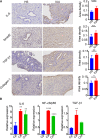Mycobiome Dysbiosis in Women with Intrauterine Adhesions
- PMID: 35730962
- PMCID: PMC9431258
- DOI: 10.1128/spectrum.01324-22
Mycobiome Dysbiosis in Women with Intrauterine Adhesions
Abstract
The vaginal microbiota dysbiosis is closely associated with the development of reproductive diseases. However, the contribution of mycobiome to intrauterine adhesion (IUA) disease remains unknown. Harnessing 16S and ITS2 rDNA sequencing analysis, we investigate both bacterial and fungal microbiota compositions across 174 samples taken from both cervical canal (CC) and middle vagina (MV) sites of IUA patients. Overall, there is no significant difference in microbial diversity between healthy subjects (HS) and IUA patients. However, we observe the IUA-specific bacterial alterations such as increased Dialister and decreased Bifidobacterium and enriched fungal genera like increased Filobasidium and Exophiala. Moreover, site-specific fungal-bacterial correlation networks are discovered in both CC and MV samples of IUA patients. Mechanistic investigation shows that Candida parapsilosis, other than Candida albicans and Candida maltosa, prevents the exacerbation of inflammatory activities and fibrosis, and modulates bacterial microbiota during IUA progression in a rat model of IUA. Our study thus highlights the importance of mycobiota in IUA progression, which may facilitate the development of therapeutic target for IUA prevention. IMPORTANCE Intrauterine adhesion (IUA) often leads to hypomenorrhea, amenorrhea, repeat miscarriages, and infertility. It has been prevalent over the last few decades in up to 13% of women who experience pregnancy termination during the first trimester, and 30% of women undergo dilation and curettage after a late, spontaneous abortion. However, the pathogenesis of IUA remains unclear. Despite reports of microbiota dysbiosis during IUA progression, there is little information on the effect of fungal microbiota on the development of IUA. This study not only enhances our understanding of the mycobiome in IUA patients but also provides potential intervention strategies for prevention of IUA by targeting mycobiome.
Keywords: dysbiosis; fungal-bacterial correlation; intrauterine adhesions; mycobiome; reproductive tract.
Conflict of interest statement
The authors declare no conflict of interest.
Figures






Similar articles
-
Candida albicans-induced activation of the TGF-β/Smad pathway and upregulation of IL-6 may contribute to intrauterine adhesion.Sci Rep. 2023 Jan 11;13(1):579. doi: 10.1038/s41598-022-25471-0. Sci Rep. 2023. PMID: 36631456 Free PMC article.
-
Deep Grouping Analysis of the Altered Cervical Canal Microbiota in Intrauterine Adhesion Patients.Reprod Sci. 2022 Dec;29(12):3494-3507. doi: 10.1007/s43032-022-01006-w. Epub 2022 Jun 16. Reprod Sci. 2022. PMID: 35710962
-
Revealing the interaction between intrauterine adhesion and vaginal microbiota using high‑throughput sequencing.Mol Med Rep. 2019 May;19(5):4167-4174. doi: 10.3892/mmr.2019.10092. Epub 2019 Mar 27. Mol Med Rep. 2019. PMID: 30942434 Free PMC article.
-
Intrauterine adhesion.Taiwan J Obstet Gynecol. 2024 May;63(3):312-319. doi: 10.1016/j.tjog.2024.02.004. Taiwan J Obstet Gynecol. 2024. PMID: 38802193 Review.
-
Focus on the Primary Prevention of Intrauterine Adhesions: Current Concept and Vision.Int J Mol Sci. 2021 May 13;22(10):5175. doi: 10.3390/ijms22105175. Int J Mol Sci. 2021. PMID: 34068335 Free PMC article. Review.
Cited by
-
The Human Mycobiome: Colonization, Composition and the Role in Health and Disease.J Fungi (Basel). 2022 Oct 4;8(10):1046. doi: 10.3390/jof8101046. J Fungi (Basel). 2022. PMID: 36294611 Free PMC article. Review.
-
A Narrative Review Discussing the Obstetric Repercussions Due to Alterations of Personalized Bacterial Sites Developed within the Vagina, Cervix, and Endometrium.J Clin Med. 2023 Aug 1;12(15):5069. doi: 10.3390/jcm12155069. J Clin Med. 2023. PMID: 37568471 Free PMC article. Review.
-
HPV infection and vaginal microecological disorders in women with intrauterine adhesion: cross-sectional study in a Chinese population.BMC Infect Dis. 2023 Nov 27;23(1):836. doi: 10.1186/s12879-023-08659-1. BMC Infect Dis. 2023. PMID: 38012631 Free PMC article.
-
Research progress in the correlation between reproductive tract microbiota and intrauterine adhesion.Zhong Nan Da Xue Xue Bao Yi Xue Ban. 2022 Nov 28;47(11):1495-1503. doi: 10.11817/j.issn.1672-7347.2022.220130. Zhong Nan Da Xue Xue Bao Yi Xue Ban. 2022. PMID: 36481627 Free PMC article. Chinese, English.
-
Candida albicans-induced activation of the TGF-β/Smad pathway and upregulation of IL-6 may contribute to intrauterine adhesion.Sci Rep. 2023 Jan 11;13(1):579. doi: 10.1038/s41598-022-25471-0. Sci Rep. 2023. PMID: 36631456 Free PMC article.
References
-
- Wang YQ, Song XH, Wu SL, Huang YZ, Yan L, Li CZ. 2020. Comparison of autocross-linked hyaluronic acid gel and intrauterine device for preventing intrauterine adhesions in infertile patients: a randomized clinical trial. Gynecol Minim Invasive Ther 9:74–80. doi:10.4103/GMIT.GMIT_103_19. - DOI - PMC - PubMed
Publication types
MeSH terms
LinkOut - more resources
Full Text Sources
Medical

